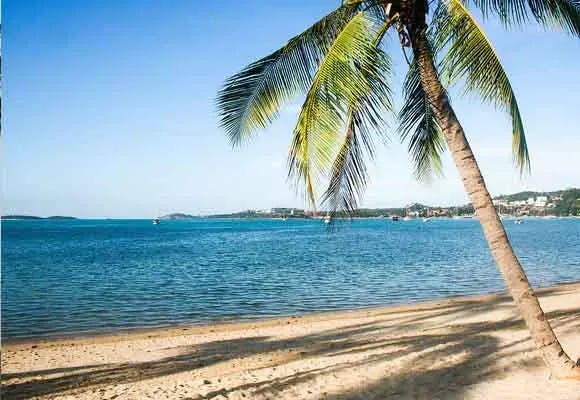By Rachel Devlin
Sometimes on the gentle winds, you may hear the lulling sounds of monks chanting, or the tinging of bells as a part of temple rituals. Big skies, rice farms, and vistas of surrounding mountains mean Chiang Rai is bursting with rustic charm.
A little further into town, large tree-lined streets, historic buildings, ancient temples as well as a large lazy river create a peaceful atmosphere.
Chiang Rai certainly offers a relaxed, slow-paced lifestyle. Although I live a few hours away from Chiang Rai, I can certainly see its appeal. I go there specifically for a relaxing getaway and also for its lively artistic community.
Known to be cooler than Bangkok it is enjoyed as a holiday destination by the Thai people and international tourists.
In the wet season, the jungle and landscape come alive with luscious pops of greens during May, June, July, August, and September.
The cool season hits during December, January, and March where the temperature will average 81 F.
The other months are generally sunny and hot. April is traditionally the hottest month with an average temperature of 91 F.
Retire in Chiang Rai

Chiang Rai is a fascinating melting pot of Thai people and peoples from Myanmar, Laos, China, and many hill tribes.
In fact, this part of Thailand was a part of Burma for around 200 years, so the cultural and artistic influences on this city make it colorful and fascinating.
Chiang Rai is around 497 miles north of Bangkok and 122 miles north of Chiang Mai, Thailand.
It is only 49 short miles south of the famous Golden Triangle where you can stand and gaze at a point where three countries meet, Thailand, Myanmar, and Laos. These countries are divided by two rivers, the Ruak River and the more famous Mekong River.
If you are looking for a place that really feels like you are ‘away’ from the toils of the western world, this is it!
But don’t despair, there are all the necessities you will need—despite the fact that you may feel like you are living in a simpler time.
Chiang Rai has shopping malls, new condo complexes, and housing developments scattered amongst traditional houses, townhouse-style shops, and markets. Its most striking feature is that nothing feels condensed. Everything is happily sprawled out amongst the leafy landscape.
There are an assortment of international schools and a major hospital. Your tastebuds can dance around a variety of restaurants offering international cuisine as well as the spicy flavors of traditional Thailand.
This place has a surprising amount of infrastructure for a small city.
Lifestyle in Chiang Rai

Chiang Rai, more often than not, attracts expats that are looking for the idyllic country lifestyle. Nature lovers enjoy the mountains, hiking trails, and expansive views. Some love to garden and enjoy growing their own food, flowering gardens, and herbs. Looming skies and large, old trees create a feeling of green abundance—particularly in the wet season. Naturally, locals are selling fresh fruits and vegetables where you will be greeted with their famous Thai smiles.
There is a community of men and women who love riding motorbikes and enjoy what the open roads have to offer. The possibilities of highway adventures are boundless. The roads are remarkably smooth and well maintained making them safe for free-spirited adventurers. Although—for non-riders—there is also a good bus service that can take you to many other towns in VIP style to satisfy the quest for the outdoors.
Many also seek a life where they can live a healthier lifestyle doing yoga, qigong (a gentle martial art popular in Thailand), and meditation. There is a small community of expats who also explore Buddhism as a part of living an alternative, healthy lifestyle.
There are markets in the city and shopping malls with Western-style grocery stores to cover all your needs. Taxi’s, Grab Taxi’s, and tuk tuks are forms of public transport, but many expats either buy a car or motorbike. This is particularly so for the expats that live further out in the countryside.
The lifestyle is a relaxed one. This is not the high octane lifestyle that one may be offered by Thailand’s beach towns where climbing cliff faces or parasailing is the norm. Of course, if you want to escape to a beach holiday you can jump on a plane. Although there is a small airport in Chiang Rai, many do the three-hour bus ride to Chiang Mai and jump on the plane to Bangkok from there. A plane to the beaches from Chiang Mai is around three hours, depending on the time of year.
When you live in the country, you must also be prepared for the local farming practice of burning fields. This often happens during March, April, and May. Some expats take this opportunity to travel, some go back home to organize their taxes, and the others buy an air purifier for their homes and stick it out.
Cost of living in Chiang Rai

The cost of living in Chiang Rai is a cheaper alternative to living in Chiang Mai. Rents are very affordable and there are a variety of residences on offer.
New condos with modern designs fully furnished are perfect for singles or couples who don’t want the burden of maintaining gardens and land. There are at least 15 condo buildings that are completely acceptable for ‘western expat living.’ A 30sqm fully furnished condo with one bedroom and kitchenette will only set you back $250 per month. That is a great deal in itself but it also includes a washing machine, TV, microwave, and security.
If you are one to enjoy your own plot of land, houses are aplenty. It is certainly a renter’s market at the moment. Thailand has two options for houses. There are ‘moo baans’ which are a community of houses with a gated entrance. There are many modern options and you can also find some that are fully furnished. A 150 square meter house in a moo baan with three bedrooms, three bathrooms, and a kitchen will only require $465 per month.
If you are looking for a more rustic local experience, you can rent a regular two-bedroom house with a kitchen and two bathrooms plus gardens for around $300 per month. Make sure you check to see if it comes with air conditioning before you sign the lease.
Utility bills are also pretty reasonable. An average monthly water bill for two people will cost around $8 per month but the electricity bill is variable. If you do not use air conditioning at all it will only be approximately $15 per month. But if you like to blast considerable artic air you could expect to pay up to $93 per month.
Your food bill may vary depending upon your tastes. If you eat local foods like curries and noodle dishes you can expect to live cheaply as one serve will only set you back $1.50. If you prefer western food you will pay more, as imported products like wheat, for example, are taxed by the government. So a large pizza will cost around $10 to $15.
Again, the same applies to grocery shopping. Local products are very cheap. A big bunch of bananas is only 70c, chicken breast is only $1.25 a kilo. Ground pork is around $1.80 a kilo. Beef is not farmed in Thailand, as the locals do not eat it. So ground beef could cost around $10 to $15 a kilo.
Most expats tend to do a combination of eating locally and cooking their favorite meals at home—or enjoying the diverse range of restaurants that are on offer.
Get Your Free Report on the World's Best Places to Retire in 2026
Get Your Free Report on the World's Best Places to Retire in 2026
Simply enter your email address below to sign up for our free daily postcard e-letter and we'll also send you a FREE report on The World's Top 10 Retirement Havens for 2026.

By submitting your email address, you will receive a free subscription to IL Postcards, Overseas Dream Home, The Untourist Daily and special offers from International Living and our affiliates. You can unsubscribe at any time, and we encourage you to read more about our Privacy Policy.
Things to do in Chiang Rai

Surprisingly, for a smaller city, Chiang Rai has much to do and see and is the custodian of many a beautiful treasure.
To fully engage with the local culture, many temples are worthy of a visit. The iconic Wat Rong Khun, otherwise known as the White Temple is one of the most famous landmarks and was designed by local artist Chalermchai Kositpipat. Its stark white structure speckled with Thai styled adornments make this beyond a fairy-tale spectacle.
Also find Wat Rong Suea Ten, also known as the Blue Temple. It is constantly causing sensation with its continued construction. But there are many—off the tourist track—temples too. Try Wat Phra Kaew, Wat Phra Singh, and Wat Fang Ming.
If you are interested in very special, old artefacts, another ‘must see’ place that tourists don’t know about is the Mae Fah Luang Foundation’s Ethnographic Museum. Set in a glorious garden with a traditional Thai building, this museum holds all the surviving relics of temples that have crumbled away with time. Personally, it is one of my favourite places in all of Northern Thailand.
As Chiang Rai is so close to the borders of Myanmar and Laos, it is worth zipping up by bus to see the infamous Golden Triangle. Grab a buffet lunch at the Imperial Golden Triangle Resort for $8 and watch what is happening in the countries just over the river. The House of Opium down the road will also tell you some interesting tales about the past opium trade in the area.
Another highlight there is the Chiang Saen National Museum, sitting on an ancient archaeological site. This holds many ancient artefacts from one of the oldest cities in Thailand.
If you are heading to Chiang Rai and want to settle in and spend some quality time, the local Expat Club is friendly and has lots of activities. There are coffee morning meet ups and lunches. They do tours to local sites and historic sites as well as run educational courses on local interests. They are a friendly bunch.
If you want to meet up with expats in the evening, swing by Rose Bar which is just opposite the Wangcome Hotel. There you will find a bunch of Americans, Australians, and Canadians having a few evening beers. They are a lively bunch and have a wealth of local knowledge.









